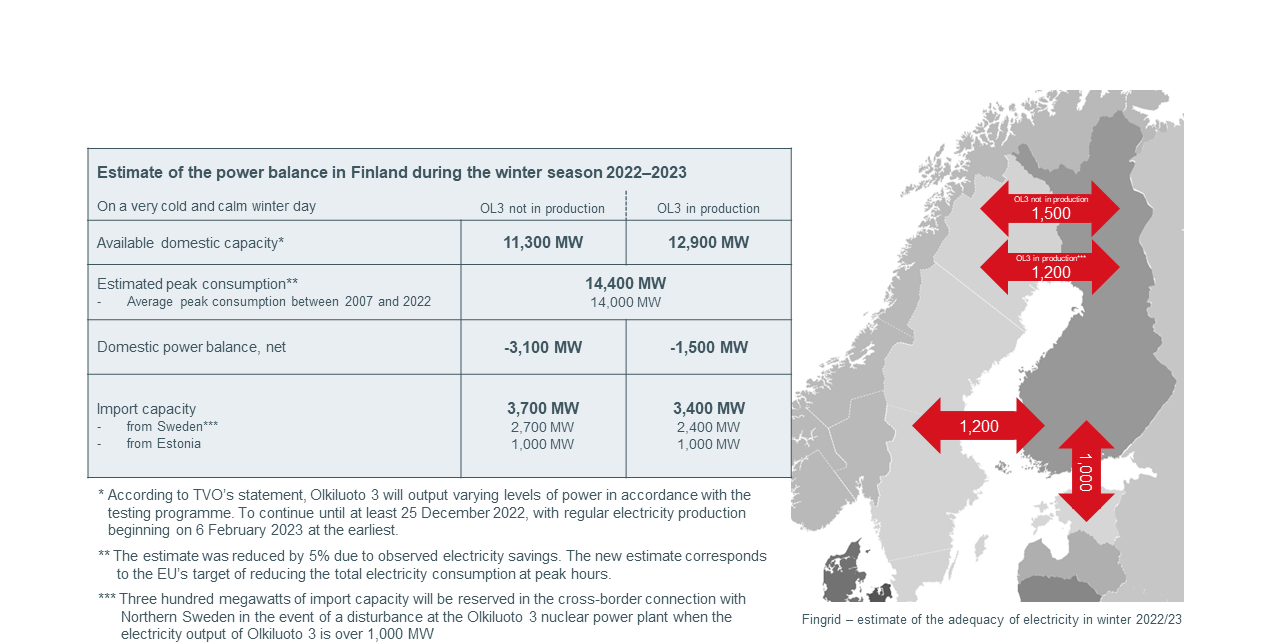Fingrid has updated its estimate of the adequacy of electricity for this winter: less Finnish production capacity available than expected, saving electricity is important
Fingrid updated its estimate of the adequacy of electricity in the coming winter on 9 December 2022. There is now a greater risk of electricity shortages on cold winter days because the commissioning of Olkiluoto 3 has been delayed.
There will be less Finnish production capacity available than previously estimated, highlighting the importance of saving electricity and scheduling consumption to ensure the adequacy of electricity. On the other hand, the full combined heat and power (CHP) production capacity is not yet in use, but the availability of Finnish electricity production has proven to be in line with the previous estimate. The commissioning of the Meri-Pori power plant and the replenishment of reservoirs in Norway are good news for the Nordic situation.
In the coming winter, the electricity consumption peak is estimated to be 14,400 megawatts. Consumption is highly dependent on the temperature, and it is typically at its highest during the coldest days of January and February. The estimate takes into account the reduction in electricity consumption this autumn as consumers saved electricity. It is important to continue saving electricity to safeguard the adequacy of electricity. It would also dramatically improve the adequacy of electricity if consumers could schedule their electricity consumption to avoid the peak hours of weekday mornings and evenings. Reducing electricity consumption by approximately 10 per cent during peak hours would save almost as much electricity as the Olkiluoto 3 unit produces.

Photo: Estimate of electricity generation and consumption in the 2022–2023 winter season on a very cold winter’s day with no wind (updated 9 December 2022)
“In the first week of December, we confirmed that the estimate we made in the early autumn of the availability of Finnish electricity production was correct, except for the unfortunate delay to Olkiluoto 3. However, the electricity-saving measures that began in the autumn and the voluntary power system support procedure for companies and municipalities significantly improve the outlook for the adequacy of electricity in the winter. These measures will allow us to avoid electricity shortages. Furthermore, there are substantial uncertainties around the adequacy of electricity related to the weather in the coming winter and the amount of electricity available for import from Southern Sweden. Therefore, we are monitoring the state of electricity markets in the Baltic Sea region to gauge the availability of imports,” states Tuomas Rauhala, Senior Vice President of Power System Operation at Fingrid.
Fingrid will update its estimate of the adequacy of electricity for the coming winter as the situation changes.
Further information:
Tuomas Rauhala, Senior Vice President, Fingrid Oyj, tel. +358 40 506 4695
Previous press releases on the power balance in the winter:
Fingrid press release on 3 October 2022: Fingrid has updated its estimate of the adequacy of electricity in the coming winter: electricity consumption has decreased – energy-saving measures must continue – Fingrid
Information about electricity shortages and how they are handled: https://www.fingrid.fi/en/grid/information-regarding-electricity-shortages/
Fact box: Key factors affecting the adequacy of electricity
- In this winter, the weather will have a major impact on peak consumption and the availability of electricity from wind turbines. The actual peak consumption is lower if the weather is mild, and wind power output is higher at times of windy weather.
- Production capacity of power plants in operation. The production capacity may be affected by failures and the lack of availability of power plant fuels, such as natural gas, biomass and peat.
- The reliability of transmission connections to ensure import capacity. The availability of imports may also be affected by internal problems with the adequacy of electricity in the exporting countries.
